#Semantic Knowledge Graphing
Explore tagged Tumblr posts
Text
Semantic Knowledge Graphing Market Size, Share, Analysis, Forecast, and Growth Trends to 2032: Transforming Data into Knowledge at Scale
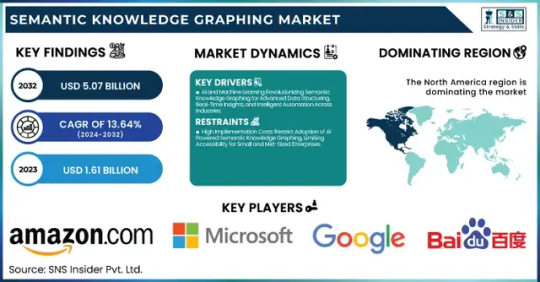
The Semantic Knowledge Graphing Market was valued at USD 1.61 billion in 2023 and is expected to reach USD 5.07 billion by 2032, growing at a CAGR of 13.64% from 2024-2032.
The Semantic Knowledge Graphing Market is rapidly evolving as organizations increasingly seek intelligent data integration and real-time insights. With the growing need to link structured and unstructured data for better decision-making, semantic technologies are becoming essential tools across sectors like healthcare, finance, e-commerce, and IT. This market is seeing a surge in demand driven by the rise of AI, machine learning, and big data analytics, as enterprises aim for context-aware computing and smarter data architectures.
Semantic Knowledge Graphing Market Poised for Strategic Transformation this evolving landscape is being shaped by an urgent need to solve complex data challenges with semantic understanding. Companies are leveraging semantic graphs to build context-rich models, enhance search capabilities, and create more intuitive AI experiences. As the digital economy thrives, semantic graphing offers a foundation for scalable, intelligent data ecosystems, allowing seamless connections between disparate data sources.
Get Sample Copy of This Report: https://www.snsinsider.com/sample-request/6040
Market Keyplayers:
Amazon.com Inc. (Amazon Neptune, AWS Graph Database)
Baidu, Inc. (Baidu Knowledge Graph, PaddlePaddle)
Facebook Inc. (Facebook Graph API, DeepText)
Google LLC (Google Knowledge Graph, Google Cloud Dataproc)
Microsoft Corporation (Azure Cosmos DB, Microsoft Graph)
Mitsubishi Electric Corporation (Maisart AI, MELFA Smart Plus)
NELL (Never-Ending Language Learner, NELL Knowledge Graph)
Semantic Web Company (PoolParty Semantic Suite, Semantic Middleware)
YAGO (YAGO Knowledge Base, YAGO Ontology)
Yandex (Yandex Knowledge Graph, Yandex Cloud ML)
IBM Corporation (IBM Watson Discovery, IBM Graph)
Oracle Corporation (Oracle Spatial and Graph, Oracle Cloud AI)
SAP SE (SAP HANA Graph, SAP Data Intelligence)
Neo4j Inc. (Neo4j Graph Database, Neo4j Bloom)
Databricks Inc. (Databricks GraphFrames, Databricks Delta Lake)
Stardog Union (Stardog Knowledge Graph, Stardog Studio)
OpenAI (GPT-based Knowledge Graphs, OpenAI Embeddings)
Franz Inc. (AllegroGraph, Allegro CL)
Ontotext AD (GraphDB, Ontotext Platform)
Glean (Glean Knowledge Graph, Glean AI Search)
Market Analysis
The Semantic Knowledge Graphing Market is transitioning from a niche segment to a critical component of enterprise IT strategy. Integration with AI/ML models has shifted semantic graphs from backend enablers to core strategic assets. With open data initiatives, industry-standard ontologies, and a push for explainable AI, enterprises are aggressively adopting semantic solutions to uncover hidden patterns, support predictive analytics, and enhance data interoperability. Vendors are focusing on APIs, graph visualization tools, and cloud-native deployments to streamline adoption and scalability.
Market Trends
AI-Powered Semantics: Use of NLP and machine learning in semantic graphing is automating knowledge extraction and relationship mapping.
Graph-Based Search Evolution: Businesses are prioritizing semantic search engines to offer context-aware, precise results.
Industry-Specific Graphs: Tailored graphs are emerging in healthcare (clinical data mapping), finance (fraud detection), and e-commerce (product recommendation).
Integration with LLMs: Semantic graphs are increasingly being used to ground large language models with factual, structured data.
Open Source Momentum: Tools like RDF4J, Neo4j, and GraphDB are gaining traction for community-led innovation.
Real-Time Applications: Event-driven semantic graphs are now enabling real-time analytics in domains like cybersecurity and logistics.
Cross-Platform Compatibility: Vendors are prioritizing seamless integration with existing data lakes, APIs, and enterprise knowledge bases.
Market Scope
Semantic knowledge graphing holds vast potential across industries:
Healthcare: Improves patient data mapping, drug discovery, and clinical decision support.
Finance: Enhances fraud detection, compliance tracking, and investment analysis.
Retail & E-Commerce: Powers hyper-personalized recommendations and dynamic customer journeys.
Manufacturing: Enables digital twins and intelligent supply chain management.
Government & Public Sector: Supports policy modeling, public data transparency, and inter-agency collaboration.
These use cases represent only the surface of a deeper transformation, where data is no longer isolated but intelligently interconnected.
Market Forecast
As AI continues to integrate deeper into enterprise functions, semantic knowledge graphs will play a central role in enabling contextual AI systems. Rather than just storing relationships, future graphing solutions will actively drive insight generation, data governance, and operational automation. Strategic investments by leading tech firms, coupled with the rise of vertical-specific graphing platforms, suggest that semantic knowledge graphing will become a staple of digital infrastructure. Market maturity is expected to rise rapidly, with early adopters gaining a significant edge in predictive capability, data agility, and innovation speed.
Access Complete Report: https://www.snsinsider.com/reports/semantic-knowledge-graphing-market-6040
Conclusion
The Semantic Knowledge Graphing Market is no longer just a futuristic concept—it's the connective tissue of modern data ecosystems. As industries grapple with increasingly complex information landscapes, the ability to harness semantic relationships is emerging as a decisive factor in digital competitiveness.
About Us:
SNS Insider is one of the leading market research and consulting agencies that dominates the market research industry globally. Our company's aim is to give clients the knowledge they require in order to function in changing circumstances. In order to give you current, accurate market data, consumer insights, and opinions so that you can make decisions with confidence, we employ a variety of techniques, including surveys, video talks, and focus groups around the world.
Contact Us:
Jagney Dave - Vice President of Client Engagement
Phone: +1-315 636 4242 (US) | +44- 20 3290 5010 (UK)
#Semantic Knowledge Graphing Market#Semantic Knowledge Graphing Market Share#Semantic Knowledge Graphing Market Scope#Semantic Knowledge Graphing Market Trends
1 note
·
View note
Text
What Is the Master Data Ontology Manager?
The Master Data Ontology Manager is a specialized solution developed by PiLog to provide a semantic framework for managing master data. It enables the creation and maintenance of ontologies — formal representations of categories, relationships, attributes, and rules that describe a specific domain of knowledge. In simple terms, it gives your data context.
Instead of merely storing data as flat records, PiLog’s Ontology Manager organizes it hierarchically and semantically — allowing machines and humans to understand not only what the data is, but also how it relates to other data.
For example: A "pump" in an equipment database isn’t just a label — it belongs to a broader category of "mechanical devices," has attributes like flow rate and pressure, and is used in contexts like oil refineries or water treatment plants. Ontology allows this rich metadata to be embedded within the data model itself.
Why Is Ontology Important in Master Data?
Traditional data models often lack the sophistication to capture contextual meaning, domain-specific logic, and interrelationships between data elements. This leads to:
Inconsistent terminology across departments
Difficulty integrating data from multiple systems
Poor data quality and limited reuse
Ineffective search and analytics capabilities
PiLog’s Master Data Ontology Manager solves these problems by enforcing semantic consistency, making data discoverable, shareable, and reusable across the enterprise. This is especially valuable for large organizations with complex product lines, global operations, and diverse regulatory requirements.
#Ontology Management#Semantic Classification#Master Data Quality#Knowledge Graph#Data Standardization
0 notes
Text
#graphrag#esg sustainability#semantic graph model#esg domains#knowledge graph llm#esg and nlp#graph rag llm
0 notes
Text
As can be observed with the Semantic Web, where information is more useful if it is expressly linked to other information, associating new knowledge with existing knowledge in a data infrastructure may present researchers with a transformative tool rather than the paginated metaphor of the Web. The linking of snippets of knowledge, or as semantic assertions via a browsable (knowledge) graph, to form insight, understanding and new knowledge, can have both advantages (trust through association) and disadvantages (incorrect assertions).
Jennifer Edmond , Nicola Horsley , Jörg Lehmann and Mike Priddy: The Trouble With Big Data: How Datafication Displaces Cultural Practices. Bloomsbury. 2022 p. 65
8 notes
·
View notes
Text
How AEO for Google Gemini is Transforming Search Experience?

The world of online search is changing rapidly, driven by the rise of generative AI and conversational interfaces. Traditional keyword-based SEO strategies, while still relevant, are no longer sufficient to meet the demands of new search ecosystems like Google Gemini. Google Gemini, part of the Search Generative Experience (SGE), leverages large language models (LLMs) to provide users with comprehensive, conversational answers instead of a simple list of links.
This shift is revolutionising how users interact with search engines. They now expect direct answers, contextual insights, and follow-up suggestions—all in one place. For brands and businesses, this presents both a challenge and an opportunity. The key to unlocking visibility in this new environment lies in AEO (Answer Engine Optimisation). Let's explore how AEO for Google Gemini is becoming indispensable for visibility and how it’s transforming the search experience.
The Role of AEO in the Gemini Era
AEO is the practice of optimising content to provide direct, machine-readable answers to user queries. Unlike traditional SEO, which focuses on keywords and backlinks, AEO focuses on entities, structured data, semantic search, and intent-driven content. Here's how the AEO agency aligns with Google Gemini:
Structured Data & Schema Markup: Helps Gemini understand your content contextually.
Entity-Based Optimisation: Connects your brand with key concepts and topics in Google’s Knowledge Graph.
Conversational Content Design: Anticipates and answers user questions in a natural, flowing tone.
Zero-Click Optimisation: Prepares your content to be cited directly in AI-generated answers, even if users don’t click.
How AEO Enhances the User Experience?
AEO for Bard users receive more than just links—they get solutions. It enables this transformation in several ways:
Faster Decision Making: Structured, concise answers help users take action quickly.
Deeper Engagement: Contextual content encourages follow-up questions and deeper exploration.
Credibility & Trust: Well-optimised AEO content often includes author credentials, sources, and real-world data, earning trust from both the AI and the user.
By aligning content with AI's understanding, AEO ensures that businesses remain visible in the evolving SERPs.
AEO in Action: Future-Proofing Digital Visibility
With AEO for Google Gemini, search is evolving into a dialogue. AEO helps brands stay part of the conversation by:
Creating FAQ-rich content that anticipates multiple intents.
Structuring articles using semantic clusters.
Leveraging JSON-LD schemas to define people, places, products, and reviews.
Designing mobile-first, snippet-friendly layouts.
End Notes
As Google Gemini reshapes the digital landscape, AEO for Google Gemini is no longer optional—it’s essential. Businesses that fail to adapt risk becoming invisible in a world where AI chooses what content to surface.
ThatWare LLP is at the forefront of AEO innovation, offering advanced strategies backed by Hyper-Intelligence™, NLP, and semantic SEO expertise. Whether you're a startup or an enterprise, they can help you align your content with Google Gemini’s intelligent requirements and maximise your visibility in AI-driven results.
0 notes
Text
Future-Proof Your SEO Strategy with Generative Engine Optimization
Step into the next era of digital marketing with Generative Engine Optimization (GEO) by ThatWare LLP. As AI-driven search engines evolve, traditional SEO alone is no longer enough. GEO optimizes your content for AI-powered platforms like Google's SGE and ChatGPT, enhancing visibility in conversational and generative search results. ThatWare LLP’s cutting-edge techniques include semantic structuring, knowledge graph integration, and intent-based optimization to ensure maximum reach. Stay ahead of the curve and make your brand discoverable in emerging AI search landscapes. Embrace the future of search with ThatWare LLP’s Generative Engine Optimization and elevate your digital presence like never before.
0 notes
Text
Hybrid AI Systems: Combining Symbolic and Statistical Approaches
Artificial Intelligence (AI) over the last few years has been driven primarily by two distinct methodologies: symbolic AI and statistical (or connectionist) AI. While both have achieved substantial results in isolation, the limitations of each approach have prompted researchers and organisations to explore hybrid AI systems—an integration of symbolic reasoning with statistical learning.
This hybrid model is reshaping the AI landscape by combining the strengths of both paradigms, leading to more robust, interpretable, and adaptable systems. In this blog, we’ll dive into how hybrid AI systems work, why they matter, and where they are being applied.
Understanding the Two Pillars: Symbolic vs. Statistical AI
Symbolic AI, also known as good old-fashioned AI (GOFAI), relies on explicit rules and logic. It represents knowledge in a human-readable form, such as ontologies and decision trees, and applies inference engines to reason through problems.
Example: Expert systems like MYCIN (used in medical diagnosis) operate on a set of "if-then" rules curated by domain experts.
Statistical AI, on the other hand, involves learning from data—primarily through machine learning models, especially neural networks. These models can recognise complex patterns and make predictions, but often lack transparency and interpretability.
Example: Deep learning models used in image and speech recognition can process vast datasets to identify subtle correlations but can be seen as "black boxes" in terms of reasoning.
The Need for Hybrid AI Systems
Each approach has its own set of strengths and weaknesses. Symbolic AI is interpretable and excellent for incorporating domain knowledge, but it struggles with ambiguity and scalability. Statistical AI excels at learning from large volumes of data but falters when it comes to reasoning, abstraction, and generalisation from few examples.
Hybrid AI systems aim to combine the strengths of both:
Interpretability from symbolic reasoning
Adaptability and scalability from statistical models
This fusion allows AI to handle both the structure and nuance of real-world problems more effectively.
Key Components of Hybrid AI
Knowledge Graphs: These are structured symbolic representations of relationships between entities. They provide context and semantic understanding to machine learning models. Google’s search engine is a prime example, where a knowledge graph enhances search intent detection.
Neuro-symbolic Systems: These models integrate neural networks with logic-based reasoning. A notable initiative is IBM’s Project Neuro-Symbolic AI, which combines deep learning with logic programming to improve visual question answering tasks.
Explainability Modules: By merging symbolic explanations with statistical outcomes, hybrid AI can provide users with clearer justifications for its decisions—crucial in regulated industries like healthcare and finance.
Real-world Applications of Hybrid AI
Healthcare: Diagnosing diseases often requires pattern recognition (statistical AI) and domain knowledge (symbolic AI). Hybrid systems are being developed to integrate patient history, medical literature, and real-time data for better diagnostics and treatment recommendations.
Autonomous Systems: Self-driving cars need to learn from sensor data (statistical) while following traffic laws and ethical considerations (symbolic). Hybrid AI helps in balancing these needs effectively.
Legal Tech: Legal document analysis benefits from NLP-based models combined with rule-based systems that understand jurisdictional nuances and precedents.
The Role of Hybrid AI in Data Science Education
As hybrid AI gains traction, it’s becoming a core topic in advanced AI and data science training. Enrolling in a Data Science Course that includes modules on symbolic logic, machine learning, and hybrid models can provide you with a distinct edge in the job market.
Especially for learners based in India, a Data Science Course in Mumbai often offers a diverse curriculum that bridges foundational AI concepts with cutting-edge developments like hybrid systems. Mumbai, being a major tech and financial hub, provides access to industry collaborations, real-world projects, and expert faculty—making it an ideal location to grasp the practical applications of hybrid AI.
Challenges and Future Outlook
Despite its promise, hybrid AI faces several challenges:
Integration Complexity: Merging symbolic and statistical approaches requires deep expertise across different AI domains.
Data and Knowledge Curation: Building and maintaining symbolic knowledge bases (e.g., ontologies) is resource-intensive.
Scalability: Hybrid systems must be engineered to perform efficiently at scale, especially in dynamic environments.
However, ongoing research is rapidly addressing these concerns. For instance, tools like Logic Tensor Networks (LTNs) and Probabilistic Soft Logic (PSL) are providing frameworks to facilitate hybrid modelling. Major tech companies like IBM, Microsoft, and Google are heavily investing in this space, indicating that hybrid AI is more than just a passing trend—it’s the future of intelligent systems.
Conclusion
Hybrid AI systems represent a promising convergence of logic-based reasoning and data-driven learning. By combining the explainability of symbolic AI with the predictive power of statistical models, these systems offer a more complete and reliable approach to solving complex problems.
For aspiring professionals, mastering this integrated approach is key to staying ahead in the evolving AI ecosystem. Whether through a Data Science Course online or an in-person Data Science Course in Mumbai, building expertise in hybrid AI will open doors to advanced roles in AI development, research, and strategic decision-making.
Business name: ExcelR- Data Science, Data Analytics, Business Analytics Course Training Mumbai
Address: 304, 3rd Floor, Pratibha Building. Three Petrol pump, Lal Bahadur Shastri Rd, opposite Manas Tower, Pakhdi, Thane West, Thane, Maharashtra 400602
Phone: 09108238354
Email: [email protected]
0 notes
Text
qKnow Platform – A Fusion Platform of Knowledge Graph and Large Language Models
qKnow Platform is an open-source knowledge management system designed for enterprise-level applications. It deeply integrates core capabilities such as knowledge extraction, knowledge fusion, knowledge reasoning, and knowledge graph construction.
By incorporating advanced large language model (LLM) technology, the platform significantly enhances the understanding and processing of both structured and unstructured data, enabling more intelligent and efficient knowledge extraction and semantic integration.
Leveraging the powerful reasoning and expression capabilities of LLMs, qKnow empowers organizations to rapidly build high-quality, actionable knowledge graph systems—driving intelligent decision-making and business innovation.
Gitee: https://gitee.com/qiantongtech/qKnow
GitHub: https://github.com/qiantongtech/qKnow
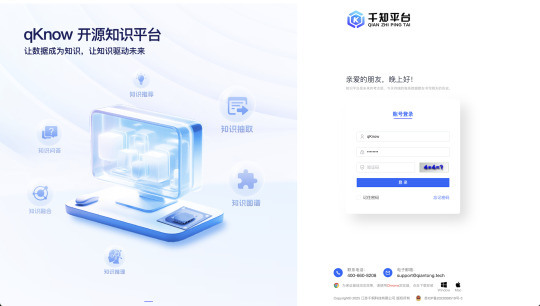

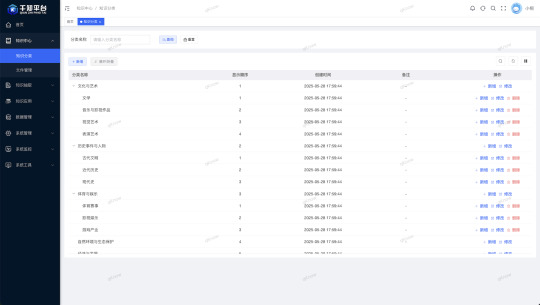




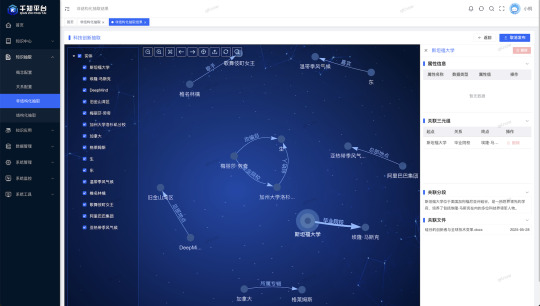


0 notes
Text
Beyond the Keyword Search: 12 AI Research Tools to Drive Knowledge Exploration
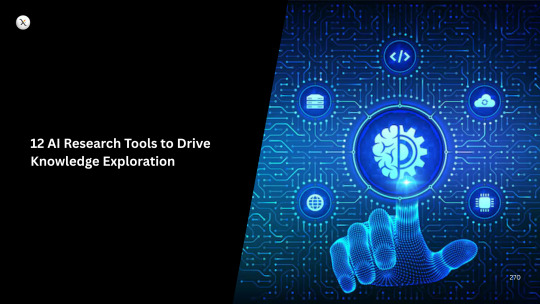
The landscape of research is undergoing a profound transformation, and Artificial Intelligence is at the forefront of this revolution. Gone are the days when knowledge exploration was solely a painstaking manual process of sifting through countless papers, books, and reports. Today, AI-powered tools are emerging as indispensable partners, augmenting human intelligence to help researchers discover, synthesize, and understand information with unprecedented speed and depth.
These tools aren't just about finding papers; they're about unearthing connections, identifying trends, summarizing complex information, and even helping you formulate new hypotheses. If you're looking to supercharge your research workflow, here are 12 AI research tools to drive your knowledge exploration:
I. Intelligent Literature Discovery & Synthesis
Elicit: Billed as an "AI Research Assistant," Elicit helps automate parts of researchers' workflows. You can ask research questions, and it will find relevant papers, summarize key findings, and even extract specific data (like methods or outcomes) from studies. It excels at quickly grasping the essence of a body of literature.
Consensus: This AI-powered search engine focuses on extracting and distilling findings directly from scientific research. Instead of just showing abstracts, Consensus reads the papers for you and presents aggregated key findings related to your search query, often with direct links to the supporting evidence.
Semantic Scholar: Beyond a simple academic search engine, Semantic Scholar uses AI to perform contextual analysis, offering "TLDR" (Too Long; Didn't Read) summaries, highlighting influential citations, and mapping connections between papers. It helps you quickly grasp the main contributions and results of a paper.
Research Rabbit: Often called the "Spotify for Papers," Research Rabbit is a powerful tool for discovering related literature. You start with one or more papers, and it builds a visual network of connected research, showing similar papers, authors, and even related research communities. It's fantastic for exploring a field organically.
Connected Papers: Similar to Research Rabbit, Connected Papers helps visualize the relationships between academic papers. By inputting a single paper, it generates a graph of directly and indirectly related works, allowing you to explore the citation landscape and identify foundational or derivative works.
Scite.ai: This tool revolutionizes how you understand citations. Instead of just counting citations, Scite.ai provides "Smart Citations" that show how a paper has been cited by others – whether it was supported, contradicted, or merely mentioned. This helps researchers critically evaluate the standing and influence of a piece of work.
Litmaps: Litmaps visualizes citation networks, helping researchers track how studies connect and evolve over time. It's excellent for understanding the intellectual lineage of ideas and identifying emerging trends or influential papers within a specific field.
II. AI for Content Comprehension & Generation
ChatPDF / AskYourPDF: These tools allow you to upload PDF documents (research papers, reports, books) and then "chat" with them. You can ask questions, summarize specific sections, clarify jargon, or extract key information, turning static documents into interactive knowledge sources.
Scholarcy: Scholarcy quickly reads and summarizes articles, reports, and book chapters, converting them into digestible "flashcards" or structured summaries. It highlights key findings, methodologies, limitations, and comparisons, significantly speeding up the literature review process.
Paperpal / QuillBot (for Academic Writing): While more focused on writing assistance, these tools are invaluable for researchers. Paperpal offers academic-specific grammar checks, paraphrasing, contextual text suggestions, and even helps find and cite references. QuillBot provides robust paraphrasing and summarization features, assisting in refining language and avoiding accidental plagiarism.
III. General-Purpose AI for Research Assistance
Perplexity AI: Acting as an "answer engine," Perplexity AI provides direct answers to your questions, drawing information from across the web and providing citations to its sources. This can be a rapid way to get an overview of a topic or find specific facts, often including academic papers in its results.
ChatGPT / Gemini / Claude: While general-purpose LLMs, these tools can be powerful research companions. They can help brainstorm research questions, outline literature reviews, explain complex concepts in simpler terms, generate initial drafts of text, or even suggest keywords for database searches. Always remember to critically verify the information generated by these models, as they can sometimes "hallucinate" facts or citations.
The Future of Research is Collaborative with AI
These 12 tools represent just a fraction of the rapidly expanding ecosystem of AI applications for research. They empower researchers to move beyond tedious manual tasks, allowing them to focus on higher-level critical thinking, analysis, and interpretation. By embracing these AI assistants, we can unlock new avenues for knowledge exploration, accelerate discovery, and ultimately drive greater innovation across all fields of study.
0 notes
Text
IEEE Transactions on Emerging Topics in Computational Intelligence Volume 9, Issue 3, June 2025
1) An Efficient Sampling Approach to Offspring Generation for Evolutionary Large-Scale Constrained Multi-Objective Optimization
Author(s): Langchun Si, Xingyi Zhang, Yajie Zhang, Shangshang Yang, Ye Tian
Pages: 2080 - 2092
2) Long-Tailed Classification Based on Coarse-Grained Leading Forest and Multi-Center Loss
Author(s): Jinye Yang, Ji Xu, Di Wu, Jianhang Tang, Shaobo Li, Guoyin Wang
Pages: 2093 - 2107
3) Two ZNN-Based Unified SMC Schemes for Finite/Fixed/Preassigned-Time Synchronization of Chaotic Systems
Author(s): Yongjun He, Lin Xiao, Linju Li, Qiuyue Zuo, Yaonan Wang
Pages: 2108 - 2121
4) Solving Multiobjective Combinatorial Optimization via Learning to Improve Method
Author(s): Te Ye, Zizhen Zhang, Qingfu Zhang, Jinbiao Chen, Jiahai Wang
Pages: 2122 - 2136
5) Multi-Objective Integrated Energy-Efficient Scheduling of Distributed Flexible Job Shop and Vehicle Routing by Knowledge-and-Learning-Based Hyper-Heuristics
Author(s): YaPing Fu, ZhengPei Zhang, Min Huang, XiWang Guo, Liang Qi
Pages: 2137 - 2150
6) MTMD: Multi-Scale Temporal Memory Learning and Efficient Debiasing Framework for Stock Trend Forecasting
Author(s): Mingjie Wang, Juanxi Tian, Mingze Zhang, Jianxiong Guo, Weijia Jia
Pages: 2151 - 2163
7) Cross-Scale Fuzzy Holistic Attention Network for Diabetic Retinopathy Grading From Fundus Images
Author(s): Zhijie Lin, Zhaoshui He, Xu Wang, Wenqing Su, Ji Tan, Yamei Deng, Shengli Xie
Pages: 2164 - 2178
8) Leveraging Neural Networks and Calibration Measures for Confident Feature Selection
Author(s): Hassan Gharoun, Navid Yazdanjue, Mohammad Sadegh Khorshidi, Fang Chen, Amir H. Gandomi
Pages: 2179 - 2193
9) Modeling of Spiking Neural Network With Optimal Hidden Layer via Spatiotemporal Orthogonal Encoding for Patterns Recognition
Author(s): Zenan Huang, Yinghui Chang, Weikang Wu, Chenhui Zhao, Hongyan Luo, Shan He, Donghui Guo
Pages: 2194 - 2207
10) A Learning-Based Two-Stage Multi-Thread Iterated Greedy Algorithm for Co-Scheduling of Distributed Factories and Automated Guided Vehicles With Sequence-Dependent Setup Times
Author(s): Zijiang Liu, Hongyan Sang, Biao Zhang, Leilei Meng, Tao Meng
Pages: 2208 - 2218
11) A Novel Hierarchical Generative Model for Semi-Supervised Semantic Segmentation of Biomedical Images
Author(s): Lu Chai, Zidong Wang, Yuheng Shao, Qinyuan Liu
Pages: 2219 - 2231
12) PurifyFL: Non-Interactive Privacy-Preserving Federated Learning Against Poisoning Attacks Based on Single Server
Author(s): Yanli Ren, Zhe Yang, Guorui Feng, Xinpeng Zhang
Pages: 2232 - 2243
13) Learning Uniform Latent Representation via Alternating Adversarial Network for Multi-View Clustering
Author(s): Yue Zhang, Weitian Huang, Xiaoxue Zhang, Sirui Yang, Fa Zhang, Xin Gao, Hongmin Cai
Pages: 2244 - 2255
14) Harnessing the Power of Knowledge Graphs to Improve Causal Discovery
Author(s): Taiyu Ban, Xiangyu Wang, Lyuzhou Chen, Derui Lyu, Xi Fan, Huanhuan Chen
Pages: 2256 - 2268
15) MSDT: Multiscale Diffusion Transformer for Multimodality Image Fusion
Author(s): Caifeng Xia, Hongwei Gao, Wei Yang, Jiahui Yu
Pages: 2269 - 2283
16) Adaptive Feature Transfer for Light Field Super-Resolution With Hybrid Lenses
Author(s): Gaosheng Liu, Huanjing Yue, Xin Luo, Jingyu Yang
Pages: 2284 - 2295
17) Broad Graph Attention Network With Multiple Kernel Mechanism
Author(s): Qingwang Wang, Pengcheng Jin, Hao Xiong, Yuhang Wu, Xu Lin, Tao Shen, Jiangbo Huang, Jun Cheng, Yanfeng Gu
Pages: 2296 - 2307
18) Dual-Branch Semantic Enhancement Network Joint With Iterative Self-Matching Training Strategy for Semi-Supervised Semantic Segmentation
Author(s): Feng Xiao, Ruyu Liu, Xu Cheng, Haoyu Zhang, Jianhua Zhang, Yaochu Jin
Pages: 2308 - 2320
19) CVRSF-Net: Image Emotion Recognition by Combining Visual Relationship Features and Scene Features
Author(s): Yutong Luo, Xinyue Zhong, Jialan Xie, Guangyuan Liu
Pages: 2321 - 2333
20) Generative Network Correction to Promote Incremental Learning
Author(s): Justin Leo, Jugal Kalita
Pages: 2334 - 2343
21) A Cross-Domain Recommendation Model Based on Asymmetric Vertical Federated Learning and Heterogeneous Representation
Author(s): Wanjing Zhao, Yunpeng Xiao, Tun Li, Rong Wang, Qian Li, Guoyin Wang
Pages: 2344 - 2358
22) HGRL-S: Towards Heterogeneous Graph Representation Learning With Optimized Structures
Author(s): Shanfeng Wang, Dong Wang, Xiaona Ruan, Xiaolong Fan, Maoguo Gong, He Zhang
Pages: 2359 - 2370
23) Prompt-Based Out-of-Distribution Intent Detection
Author(s): Rudolf Chow, Albert Y. S. Lam
Pages: 2371 - 2382
24) Multi-Graph Contrastive Learning for Community Detection in Multi-Layer Networks
Author(s): Songen Cao, Xiaoyi Lv, Yaxiong Ma, Xiaoke Ma
Pages: 2383 - 2397
25) Observer-Based Event-Triggered Optimal Control for Nonlinear Multiagent Systems With Input Delay via Reinforcement Learning Strategy
Author(s): Xin Wang, Yujie Liao, Lihua Tan, Wei Zhang, Huaqing Li
Pages: 2398 - 2409
26) SODSR: A Three-Stage Small Object Detection via Super-Resolution Using Optimizing Combination
Author(s): Xiaoyong Mei, Kejin Zhang, Changqin Huang, Xiao Chen, Ming Li, Zhao Li, Weiping Ding, Xindong Wu
Pages: 2410 - 2426
27) Toward Automatic Market Making: An Imitative Reinforcement Learning Approach With Predictive Representation Learning
Author(s): Siyuan Li, Yafei Chen, Hui Niu, Jiahao Zheng, Zhouchi Lin, Jian Li, Jian Guo, Zhen Wang
Pages: 2427 - 2439
28) CIGF-Net: Cross-Modality Interaction and Global-Feature Fusion for RGB-T Semantic Segmentation
Author(s): Zhiwei Zhang, Yisha Liu, Weimin Xue, Yan Zhuang
Pages: 2440 - 2451
29) BAUODNET for Class Imbalance Learning in Underwater Object Detection
Author(s): Long Chen, Haohan Yu, Xirui Dong, Yaxin Li, Jialie Shen, Jiangrong Shen, Qi Xu
Pages: 2452 - 2461
30) DFEN: A Dual-Feature Extraction Network-Based Open-Set Domain Adaptation Method for Optical Remote Sensing Image Scene Classification
Author(s): Zhunga Liu, Xinran Ji, Zuowei Zhang, Yimin Fu
Pages: 2462 - 2473
31) Distillation-Based Domain Generalization for Cross-Dataset EEG-Based Emotion Recognition
Author(s): Wei Li, Siyi Wang, Shitong Shao, Kaizhu Huang
Pages: 2474 - 2490
32) NeuronsGym: A Hybrid Framework and Benchmark for Robot Navigation With Sim2Real Policy Learning
Author(s): Haoran Li, Guangzheng Hu, Shasha Liu, Mingjun Ma, Yaran Chen, Dongbin Zhao
Pages: 2491 - 2505
33) Adaptive Constrained IVAMGGMM: Application to Mental Disorders Detection
Author(s): Ali Algumaei, Muhammad Azam, Nizar Bouguila
Pages: 2506 - 2530
34) Visual IoT Sensing Based on Robust Multilabel Discrete Signatures With Self-Topological Regularized Half Quadratic Lifting Functions
Author(s): Bo-Wei Chen, Ying-Hsuan Wu
Pages: 2531 - 2544
35) Heterogeneity-Aware Clustering and Intra-Cluster Uniform Data Sampling for Federated Learning
Author(s): Jian Chen, Peifeng Zhang, Jiahui Chen, Terry Shue Chien Lau
Pages: 2545 - 2556
36) Model-Data Jointly Driven Method for Airborne Particulate Matter Monitoring
Author(s): Ke Gu, Yuchen Liu, Hongyan Liu, Bo Liu, Lai-Kuan Wong, Weisi Lin, Junfei Qiao
Pages: 2557 - 2571
37) Personalized Exercise Group Assembly Using a Two Archive Evolutionary Algorithm
Author(s): Yifei Sun, Yifei Cao, Ziang Wang, Sicheng Hou, Weifeng Gao, Zhi-Hui Zhan
Pages: 2572 - 2583
38) PFPS: Polymerized Feature Panoptic Segmentation Based on Fully Convolutional Networks
Author(s): Shucheng Ji, Xiaochen Yuan, Junqi Bao, Tong Liu, Yang Lian, Guoheng Huang, Guo Zhong
Pages: 2584 - 2596
39) Low-Bit Mixed-Precision Quantization and Acceleration of CNN for FPGA Deployment
Author(s): JianRong Wang, Zhijun He, Hongbo Zhao, Rongke Liu
Pages: 2597 - 2617
40) Bayesian Inference of Hidden Markov Models Through Probabilistic Boolean Operations in Spiking Neuronal Networks
Author(s): Ayan Chakraborty, Saswat Chakrabarti
Pages: 2618 - 2632
0 notes
Text
#graphrag#esg sustainability#semantic graph model#esg domains#knowledge graph llm#esg and nlp#graph rag llm
0 notes
Text

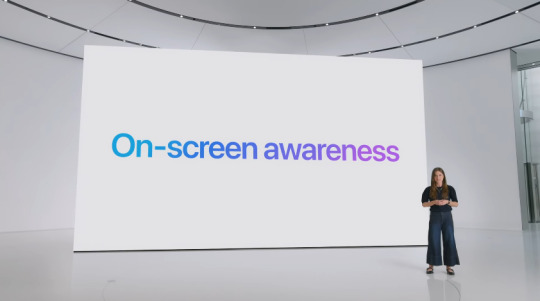

Apple WWDC 2024, screenshot of the segment on the "semantic index". The semantic index is just knowledge graph PR on their Siri development, setting the stage for AI cloud computing of personal data being their new feature, as well as a connection to ChatGPT. Worth noting that all the big players (Apple, Google, Microsoft) are doing the same thing simultaneously, introducting tighter surveillance ("on-screen awareness") directly on the operating system, in order to extract personal data for AI assistants ("intelligence that understands you"). Apple is now pushing ahead in this field exactly in one direction: using privacy scandals and the outrage against the AI economy to promise a closed wall system in their cloud. The fact that they need to build a bridge to the businesses they so theatrically distances themselves of (OpenAI/ChatGPT) shows how flimsy their own system is.
The WWDC presentation produced an image of this style of network culture. Its core selling point being a 'personal' index (how often do we hear the word "mum" in this segment...), and a personal cloud. This personal cloud then will process all your friends and family, as the presentation shows in a charming way, integrating algorithmic production in every step of personal communication (custom emojis, text rewriting, photo remixing). Everyone and everyone's communication and image is part of this "personal" computing.
"Contemporary production includes linguistic competence, knowledge, imagination, social interaction as its core sources of added value. So, the new modes of production and contemporary wealth are built not on labour power understood in classic Marxist terms, but on the appropriation of the entirety of human productive power. Terranova applies the concepts to today’s network cultures: “These are moments which turn qualitative, intensive differences into quantitative relations of exchange and equivalence; which enclose the open and dissipative potential of cultural production into differential hierarchies; which accumulate the rewards or work carried out by larger social assemblages… “ [Terranova 2006, 28] The logic of capital subsumes the potential of many platforms, and encloses it within the chain of valorization of creativity and subjectivity."
Goriunova, Olga (2007) Towards a new critique of network cultures: creativity, autonomy and late capitalism in the constitution of cultural forms on the Internet, Network Cultures
3 notes
·
View notes
Text
Revolutionizing Digital Marketing with Quantum SEO

In a world where algorithms evolve by the minute and competition for digital visibility is fiercer than ever, traditional SEO tactics are no longer enough. Enter Quantum SEO—a next-gen approach to search engine optimization that combines artificial intelligence, data science, and advanced semantic understanding to unlock unseen ranking potential. At Thatware LLP, we're leading the charge with cutting-edge Quantum SEO services designed to future-proof your online presence.
What Is Quantum SEO?
Quantum SEO is not just another buzzword in the digital marketing realm. It represents a paradigm shift in how search engines are understood and optimized for. Unlike conventional SEO, which relies heavily on keywords, backlinks, and content updates, Quantum SEO leverages:
AI-driven algorithms
Natural Language Processing (NLP)
Predictive user behavior analytics
Knowledge graphs and entity-based SEO
Machine learning for real-time SERP adaptation
It’s about understanding not just what users search for, but why they search—making your content smarter, faster, and more contextually relevant.
Why Quantum SEO Matters in 2025 and Beyond
Search engines like Google are becoming increasingly context-aware and user-intent focused. The rise of semantic search, voice assistants, and conversational AI means SEO strategies must evolve. Quantum SEO ensures your brand stays ahead by:
Enhancing search intent matching
Aligning content with Google’s E-E-A-T principles
Improving core web vitals and user experience
Utilizing AI predictions to preemptively optimize content
These innovations allow businesses to gain an unfair advantage in high-competition niches.
Quantum SEO Services at Thatware LLP
At Thatware, we’ve pioneered Quantum SEO services tailored to today’s advanced search environment. Our process includes:
AI-powered audit tools to scan and analyze your website's SEO health
Custom NLP-based content optimization
Entity-based schema markup to align with search engine knowledge graphs
Advanced competitor analysis using data modeling and reverse engineering
Semantic content clusters for topical authority building
Our approach is scientific, data-driven, and custom-tailored to each client’s industry and goals.
Real Results, Scientifically Engineered
Unlike conventional SEO providers that rely on generic packages, Thatware’s Quantum SEO services are grounded in data science and proprietary AI models. Our clients have seen dramatic increases in keyword rankings, traffic quality, and conversions—especially in highly competitive industries like finance, health, and tech.
Final Thoughts: Embrace the Quantum Leap
SEO is no longer just about keywords—it's about intelligence. By adopting Quantum SEO, your brand can step into the future of search optimization, leveraging science-backed techniques to dominate SERPs like never before.
0 notes
Text
Future-Ready SEO with Leading AEO Services Agency – Thatware’s AI-Powered Approach to Enhanced Online Visibility
In a world where search engines are shifting from keyword-based results to user intent and context, Thatware stands out as a premier AEO services agency offering cutting-edge solutions for digital success. As a leader in Answer Engine Optimization (AEO), Thatware helps businesses become the direct answer to user queries across voice search, Google’s featured snippets, and AI-driven platforms like ChatGPT and Siri. Our AI-integrated strategies focus on structured data implementation, content optimization, knowledge graph enhancement, and schema markup—all designed to align with the latest semantic search algorithms. As a trusted AEO services agency, Thatware empowers your brand to dominate zero-click searches, gain authority in your niche, and stay ahead of evolving search engine trends. From enterprises to startups, our AEO solutions future-proof your digital presence and drive higher engagement and conversions.
0 notes